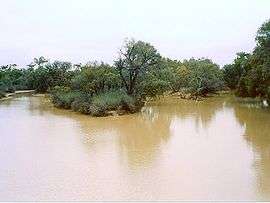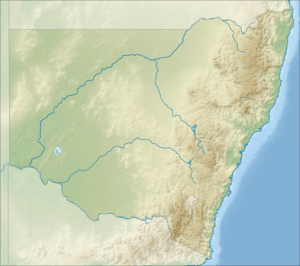Paroo River
| Paroo | |
| Paroo Channel, Paroo River Channels[1] | |
| River | |
 Paroo River at Wanaaring, New South Wales | |
| Country | Australia |
|---|---|
| States | Queensland, New South Wales |
| Regions | South West Queensland, Far West, New South Wales |
| Part of | Darling River catchment, Murray–Darling basin |
| Source | Mariala National Park |
| - location | west of Augathella, Queensland |
| - elevation | 336 m (1,102 ft) |
| - coordinates | 26°07′56″S 145°10′39″E / 26.13222°S 145.17750°E |
| Mouth | confluence with the Darling River in wetter seasons |
| - location | north of White Cliffs, New South Wales |
| - elevation | 94 m (308 ft) |
| - coordinates | 31°33′30″S 143°27′08″E / 31.55833°S 143.45222°ECoordinates: 31°33′30″S 143°27′08″E / 31.55833°S 143.45222°E |
| Length | 1,210 km (752 mi) |
| Basin | 60,095 km2 (23,203 sq mi) |
| Discharge | |
| - average | 15 m3/s (530 cu ft/s) |
| Reservoirs | Buckenby Waterhole, Humeburn Waterhole, Corni Paroo Waterhole, Caiwarro Waterhole, Thoulcanna Dam, Talyealye Billabong and Budtha Waterhole |
| National park | Mariala National Park |
 | |
| [2] | |
The Paroo River, a series of waterholes, connected in wet weather as a running stream of the Darling catchment within the Murray–Darling basin, is located in the South West region of Queensland and Far West region of New South Wales, Australia. It was the home of the Paarkantji people.
Course and features
The river rises in the gorge country of western Queensland south of the Mariala National Park, and flows generally south and spreads into the vast floodplains of New South Wales, eventually reaching the Paroo overflow lakes. Most commonly, the Paroo River terminates on the floodplain south of Wanaaring; and only reaches the Darling River in the wettest of years,[3] otherwise spilling into the Paroo River Wetlands. The river is joined by forty-three minor tributaries; as it descends 242 metres (794 ft) over its 1,210-kilometre (750 mi) course.[2]
The Paroo River is the last remaining free-flowing river in the northern part of the Murray-Darling basin;[4] and is impounded by the natural formation of the Buckenby Waterhole, Humeburn Waterhole, Corni Paroo Waterhole, Caiwarro Waterhole, Thoulcanna Dam, Talyealye Billabong and Budtha Waterhole.[2]
Wetlands
The Paroo River wetlands in north-western New South Wales are important for threatened species such as the freckled duck and the Australian painted snipe. They lie within the Paroo Floodplain and Currawinya Important Bird Area, identified as such by BirdLife International because of its importance, when conditions are suitable, for large numbers of waterbirds.[5]
On 20 September 2007, Malcolm Turnbull, the Minister for the Environment and Water Resources, announced that the Paroo River Wetlands in north-west New South Wales would be listed under the Ramsar Convention as wetlands of international importance, making them Australia's 65th Ramsar site.[4]
Gallery
See also
References
- ↑ "Paroo River". Geographical Names Register (GNR) of NSW. Geographical Names Board of New South Wales. Retrieved 10 February 2013.
- 1 2 3 "Map of Paroo River". Bonzle Digital Atlas of Australia. Retrieved 10 February 2013.
- ↑ "Paroo catchment". Commonwealth Environmental Water Office. Commonwealth of Australia. 13 December 2012. Retrieved 10 February 2013.
- 1 2 Turnbull, Malcolm (20 September 2007). "Outback NSW westland internationally recognised" (PDF). Department of Sustainability, Environment, Water, Population and Communities (Press release). Commonwealth of Australia. Retrieved 10 February 2013.
- ↑ "IBA: Paroo Floodplain & Currawinya". Birdata. Birds Australia. Archived from the original on 6 July 2011. Retrieved 13 September 2011.
